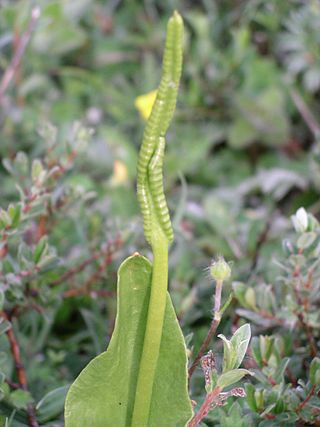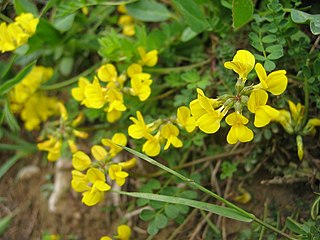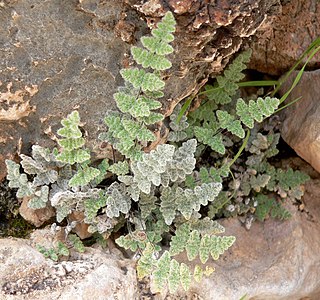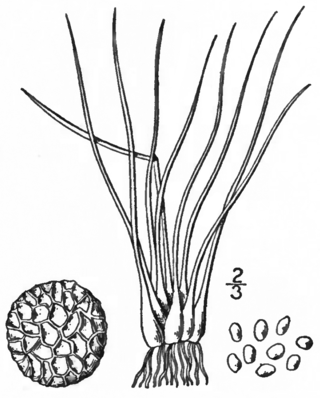
Selaginella is the sole genus in the family Selaginellaceae, the spikemosses or lesser clubmosses, a kind of vascular plant.

Isoetes, commonly known as the quillworts, is a genus of lycopod. It is the only living genus in the family Isoetaceae and order Isoetales. There are currently 192 recognized species, with a cosmopolitan distribution mostly in aquatic habitats but with the individual species often scarce to rare. Some botanists split the genus, separating two South American species into the genus Stylites, although molecular data place these species among other species of Isoetes, so that Stylites does not warrant taxonomic recognition. Species virtually identical to modern quillworts have existed since the Jurassic epoch, though the timing of the origin of modern Isoetes is subject to considerable uncertainty.

Ophioglossum, the adder's-tongue ferns, is a genus of about 50 species of ferns in the family Ophioglossaceae. The name Ophioglossum comes from the Greek meaning "snake-tongue". Their cosmopolitan distribution is mainly in tropical and subtropical habitats.

Reseda, also known as the mignonette, is a genus of fragrant herbaceous plants native to Europe, southwest Asia and North Africa, from the Canary Islands and Iberia east to northwest India. The genus includes herbaceous annual, biennial and perennial species 40–130 cm tall. The leaves form a basal rosette at ground level, and then spirally arranged up the stem; they can be entire, toothed or pinnate, and range from 1–15 cm long. The flowers are produced in a slender spike, each flower small, white, yellow, orange, or green, with four to six petals. The fruit is a small dry capsule containing several seeds.

Pilosocereus is a genus of cactus native to the Neotropics. Tree cactus is a common name for Pilosocereus species. The genera Caerulocereus and Pseudopilocereus are synonyms of this genus.

Polystichum is a genus of ferns in the family Dryopteridaceae, subfamily Dryopteridoideae, according to the Pteridophyte Phylogeny Group classification of 2016. The genus has about 500 species and has a cosmopolitan distribution. The highest diversity is in eastern Asia, with about 208 species in China alone; the region from Mexico to Brazil has at least 100 additional species; Africa, North America, and Europe have much lower diversity. Polystichum species are terrestrial or rock-dwelling ferns of warm-temperate and montane-tropical regions. They are often found in disturbed habitats such as road cuts, talus slopes, and stream banks.

Erodium is a genus of flowering plants in the botanical family Geraniaceae. The genus includes about 60 species, native to North Africa, Indomalaya, the Middle East, and Australia. They are perennials, annuals, or subshrubs, with five-petalled flowers in shades of white, pink, and purple, that strongly resemble the better-known Geranium (cranesbill). Cultivated plants are known as filarees or heron's bill in North America, whereas in the British Isles they are usually called storksbills.

Hippocrepis is a genus of flowering plants in the legume family, Fabaceae. It includes 34 species native to Europe, northern Africa, and western Asia.

Selaginella kraussiana is a species of vascular plant in the family Selaginellaceae. It is referred to by the common names Krauss' spikemoss, Krauss's clubmoss, or African clubmoss, and is found naturally in parts of Sub-Saharan Africa and in Macaronesia. It is sometimes given the misnomer of “peacock fern”, due to its lacy leaf structure, despite having no relation to actual ferns; rather, it belongs to the very ancient lineage of plants known as the clubmosses.

Spigelia is a genus of flowering plants in the family Loganiaceae. It contains around 60 species, distributed over the warmer parts of the Americas, from the latitude of Buenos Aires to the Southern United States. It was named after Adriaan van den Spiegel by Carl Linnaeus in his 1753 Species Plantarum; the type species is Spigelia anthelmia. Pinkroot is a common name for plants in this genus.

Botrychium matricariifolium is a species of fern in the Ophioglossaceae family. It is referred to by the common names chamomile grape-fern, daisyleaf grape-fern, and matricary grape-fern. It is native to Europe and parts of eastern North America, including eastern Canada and parts of the United States.

Cheilanthoideae is one of the five subfamilies of the fern family Pteridaceae. The subfamily is thought to be monophyletic, but some of the genera into which it has been divided are not, and the taxonomic status of many of its genera and species remains uncertain, with radically different approaches in use as of December 2019.

Cnidoscolus angustidens, with the common name mala mujer, is an herbaceous perennial plant in the spurge family (Euphorbiaceae).

Isoetes riparia, the shore quillwort, is a species of plant in the family Isoetaceae. It can be found in rivers, creeks, and tidal mud flats in southern Quebec and southeastern Ontario, south to eastern New York. It has 5 to 35 long, erect bright green to yellow-green leaves, which are 6 to 35 centimeters long. The velum covers one fourth of the sporangium, which can be 7 millimeters long and 4 millimeters wide. The elongated ligule can grow to be 3 millimeters long. The spherical megaspores are 430 to 680 micrometers in diameter with closely set ridges. The kidney-shaped microspores are 24-35 micrometers long, and usually have spine-tipped tubercules. The megaspores can sometimes come to resemble that of either I. echinospora, if the megaspores become eroded and bear projections that could resemble spines, or I. macrospora, if the broken ridges take a certain shape.

Isoetes tuckermanii, or Tuckerman's quillwort, is a tetraploid species of plant in the family Isoetaceae. It can be found in shallow water in Newfoundland, Nova Scotia, New Brunswick, and south through the New England states to Maryland. It bears 10 to 45 long bright green to yellow green leaves that are 4 to 25 centimeters long, usually erect, but sometimes recurved. The velum covers one fourth or less of the sporangium, which is usually unspotted, 5 millimeters long, and 3 millimeters wide. The white spherical megaspores are 400 to 650 micrometers in diameter, and bear rough-crested ridges that form a hexagonal honeycomb shape. The kidney shaped microspores are 24 to 33 micrometers long, bearing tubercles. It is very similar to I. macrospora, only reliably distinguishable by cytology or through careful megaspore measurement.
Najas tenuissima is a species of flowering plant belonging to the family Hydrocharitaceae.














